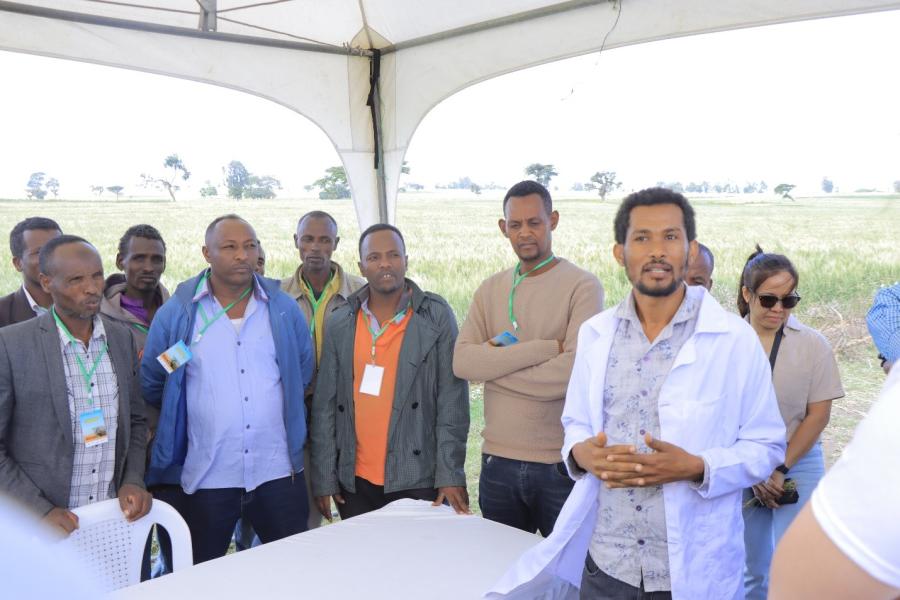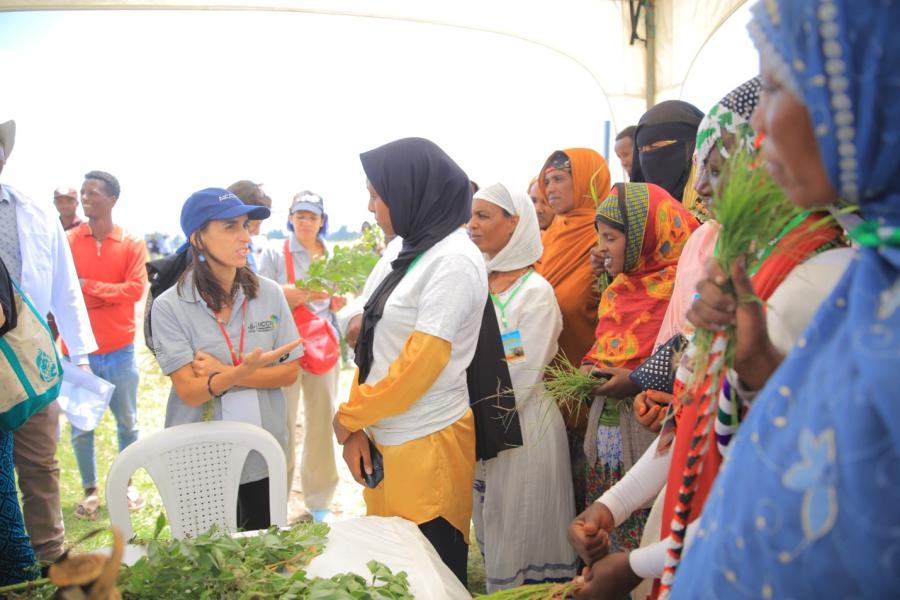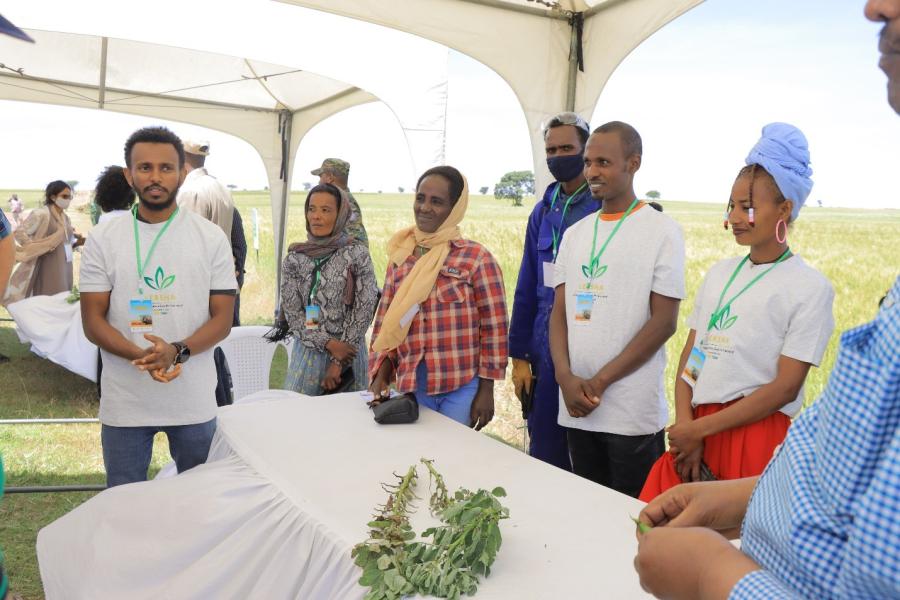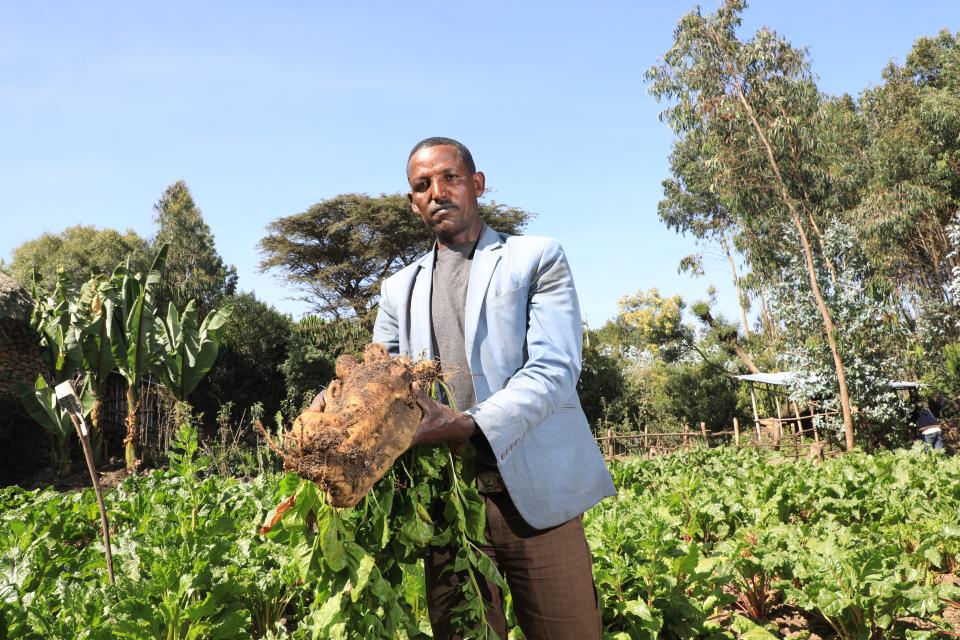

Climate-smart innovations in Ethiopia’s central wheatbelt
The visit to Ethiopia’s central Wheatbelt showcased some of the innovative solutions developed by the International Maize and Wheat Improvement Center (CIMMYT), a CGIAR Research Center, and how these solutions are being scaled up through partnerships formed by the Accelerating Impacts of CGIAR Climate Research for Africa (AICCRA) project, hosted in Ethiopia by the International Livestock Research Institute (ILRI).
This AICCRA-led partnership involves various stakeholders, including the Ethiopian Institute of Agricultural Research (EIAR), its regional centers, and a private sector innovator called Green Agro Solutions PLC (GAS).
The Kulumsa Agricultural Research Center is one of the most prominent research centers of the Ethiopian Institute of Agricultural Research (EIAR), located 160 km southeast of Ethiopia's capital, Addis Ababa. It was the first stop on a field visit organized by AICCRA-Ethiopia for stakeholders and partners from the six AICCRA project focus countries.
The day-long tour featured a 'learning journey' with a visit to the Iteya farming community, where visitors engaged in meaningful conversations with smallholder farmers and community leaders.
Such conversations led to a better understanding of how farmers in the area overcome the challenges driven by climate change, particularly in the on-site implementation of solutions that should include all in the community – particularly women and youth.
The AICCRA project contributes to Ethiopia’s efforts in modernizing agriculture by making climate information services in the form of agro-advisories and validated climate-smart agriculture innovations accessible to smallholder farmers in five regional states.
To date, the AICCRA project has reached more than 400,000 farmers in Ethiopia through a robust partnership of CGIAR centers with concerned ministries, national agriculture research systems, private sector players and international development partners.

Wheat field at the Kulumsa Agriculture Research Center
In response to this challenge, the Government of Ethiopia intends to increase wheat production as a crucial component of its Ten-Year Development Plan (2021-2030), which aims to accelerate economic progress and ensure national food security. Ethiopia is the largest wheat producer in sub-Saharan Africa and plans to become wheat self-sufficient and a net exporter by 2025/26.
Smallholder farmers are responsible for the cultivation of most Ethiopian wheat. Although their yields have gradually increased, they are still relatively low compared to global standards.
As such, various government-led and international institution-backed initiatives are working to enhance farmers' access to markets and improve their agronomic practices by providing them with better technology and inputs.
The Significance of Wheat in Ethiopia’s Reformed Agricultural Roadmap
Agriculture remains central to the livelihoods of millions of people in Ethiopia, with more than 80% of the country’s population relying on subsistence farming for nutrition and income.
Wheat is a valuable crop for Ethiopia. Ethiopia is the leading producer of wheat in Sub-Saharan Africa, dedicating more land to the crop than any other country in the region. However, the compounding impacts of climate change and climate variability, combined with weather-dependent and traditional methods of agriculture, have resulted in reduced yields and increased food insecurity in the region.

A farmer and a researcher interact at Kulumsa
At the Kulumsa Agricultural Research Center—a renowned center of excellence for wheat research in East Africa covering Ethiopia, Kenya, Uganda, and Tanzania—research on wheat, malt barley, and highland pulse crops is conducted, focused on developing better technologies that improve agricultural production and its commercialization in the central wheat belt region of Ethiopia. These efforts are aimed at enhancing select value chains in clustered districts in Ethiopia, also known as ‘Woredas’.
With the support of AICCRA, CIMMYT has collaborated with EIAR through the Kulumsa Center to improve climate-smart agricultural technologies and popularize them with smallholder farmers.
The tour showcased the various climate-resilient wheat varieties that researchers at the center grow and monitor in their fields.
Bundling climate information services and seeds, inputs and mechanization services for smallholder farmers
Additionally, researchers at Kulumsa are working to promote the use of planting and harvesting machines to improve productivity and increase efficiency. The mechanization service to the farmers is provided in association with private sector and youth groups who act as service providers.
Dr. Kindie Tesfaye, Principal Scientist at CIMMYT and an activity leader for AICCRA in Ethiopia, explained how Kulumsa not only generates technologies but also delivers them to farmers by bundling services with climate advisories.
“Seeds alone do not do the job. Information alone does not do the job. Inputs alone do not do the job either. They need to be integrated; that’s why we’re bundling these services for farmers’’
Dr. Kindie Tesfaye
The director of Kulumsa Agricultural Research Center, Dr. Debele Debela, spoke to the visitors about the critical role of accurate weather forecasting in mitigating climate-related risks in agriculture.

Researchers based at Kulumsa Agricultural Research Center
An AICCRA-led partnership between CIMMYT, the Alliance of Bioversity International and CIAT, and ILRI developed an improved version 2.0 of the Ethiopian Digital Agro-Climate Advisory Platform (EDACaP), which is hosted by the Ethiopian Institute of Agricultural Research (EIAR).
Kulumsa is among the three major agricultural research centers that gather necessary data to enables EDACaP 2.0 to produce seasonal climate and weather advisories for smallholder farmers growing wheat, maize, sorghum, teff, and barley.
The advisories developed in EDACaP are then integrated with an app called Lersha (meaning ‘for agriculture’ in Amharic) developed by Green Agro Solution PLC (GAS) to disseminate timely and relevant climate information to Ethiopian farmers, including those in the Iteya community.
Lersha is an innovative decision support tool—in the form of a phone app—designed for farmers to turn climate information into actionable knowledge by making accessible climate-informed agro-advisories, which are ‘bundled’ with information on farming inputs, mechanization services as well as financial services.
GAS has so far provided bundled agro-advisory services to 229,192 smallholder farmers and 6,717 development agents in the Amhara, Oromia, and Somali regions. They access this information through SMS, the Lersha mobile application, and call center every two weeks.
Government development agents and Lersha agents work with farmers’ unions to facilitate the process by ensuring farmers can access, understand, and use the information to make better-informed decisions at the farm level. These integrated efforts to increase productivity have already shown positive results.
Use of the Lersha app is improving the adoption of improved seed varieties across the regions where it is active.
Meeting the farming communities of Iteya
The Iteya area in the Oromia regional state has fertile land and a favorable agro-ecological zone, making agriculture the primary economic activity. The region's economy is highly dependent on smallholder farmers who cultivate cash crops like wheat, as well as a variety of other crops such as barley, teff, faba bean, field pea, and potato.
During the field visit, a cluster of wheat farms of the Hitossa Union, a group of 163 cooperatives representing over 95,000 smallholder farmers.
Four on-site field groups were created to engage visitors in conversations about the challenges, opportunities, and needs facing the farmers. These groups included women-only farmers, men-only farmers, youth development agents from both the local agriculture bureau and Lersha, and a Hitossa Union.
Visitors also enjoyed traditional dairy products and freshly harvested faba beans during the discussions.

Warm traditional welcoming from Hadde Sinqaes (respected women elders in the community) and Aba Gedas (respected male elders in the Oromo community) opening the program with blessings
Key challenges the farmers and union representatives emphasized during the discussions included increasing climate variability, knowing when to plant, and access to water and fertilizer inputs.
The farmers told visitors that through the partnerships of the AICCRA project, they had been provided with climate advisory services, easier access to inputs and mechanization, and opportunities for them to meet agronomists and agricultural experts.
With support and training, the farmers said their productivity has increased, and they now know how to market their produce. According to the farmers, the capacity-building training given to farmers and development agents has helped them to communicate their needs and build trust with the project.
Farmers thanked the partnership between CIMMYT and GAS—now being scaled by AICCRA—for showing them ways to access markets and use their produce beyond the surplus level.
The team behind Lersha is now working with different financial organizations to open doors for farmers to get crop insurance in case of yield loss.
Answering a visitor’s question on what makes their roles enjoyable one of the development agents replied:
“We work very hard to make sure the farmers understand the advisory services, and they also get access to inputs and mechanization. We are very satisfied when we see they implement our advice and become profitable.”
Abdela Nasir
The administration team from the Hitossa Farmers Union spoke to the guests about how they are working with farmers to build their resilience and increase their uptake of climate-smart agriculture. They shared plans to set up a local factory to manufacture liquid fertilizer in the area to meet growing fertilizer needs and boost the local economy.
Dawit Solomon, the Ethiopia Lead for AICCRA, expressed gratitude for the warm welcome and hospitality from the farmers, agents, and workers at Hitossa Union.
“We are very fortunate to be working with you. We are happy that we have such a community to serve. It is a great thing for us to identify your problems and assist you to overcome them in the ways we can.”
Kindie Tesfaye of CIMMYT Ethiopia expressed gratitude to the farmers and hosts for their hospitality.
“I second what Dr. Dawit said. We come here to work with you because you are the ones who helped us get educated. We were born to parents like you. We are where we are today because you worked hard for our sake. Now it’s time for us to give back in any way we can.”



The big picture: Shaping Agriculture for Greater Impact in Ethiopia
The field trip was held alongside a broader program of activities hosted by AICCRA at the ILRI campus in Addis Ababa, including a Public Forum focused on ‘Shaping Agriculture for Greater Impact in Ethiopia.’
"By strengthening the technical, institutional & human capacity of Ethiopian institutions... [AICCRA] is helping to deploy climate information services and packages of technology & innovation more effectively for climate-smart agriculture."
Dr. Namukolo Covic, ILRI Director General Representative to Ethiopia.
The forum was a gathering of representatives from public institutions, private sector actors, development partners, academia, and research, which included Addis Ababa University, Ethiopian Meteorology Institute, Amhara Agricultural Research Institute (ARARI) and Inter Aide.
The purpose of the forum was to discuss ways to strengthen collaborations and partnerships that support various national initiatives in Ethiopia for the science-based transformation of its agricultural sector to boost economic growth and community resilience.
The Keynote speaker was Dr. Yifru Tafesse, Deputy CEO of the Ethiopian Agricultural Transformation Institute (ATI). He shared Ethiopia’s agricultural transformation initiatives and how AICCRA and partners contribute to national efforts to build resilience and promote climate-smart agriculture.
Building resilient agricultural systems capable of adapting to climate change is critical. @EthiopianATA is committed to strengthening its partnership with @CGIARAfrica in promoting smallholder farmer's adoption of climate smart agriculture technologies.#RedayToScale pic.twitter.com/2Au57QhjVy
— Ethiopian Agricultural Transformation Institute (@EthiopianATA) October 17, 2023
We were also honored to be joined by farmers from Oromia, SNNP and Amhara regions in Ethiopia who shared how climate information services and climate-smart agriculture technologies, supported by AICCRA and others, are making a positive impact in their lives and communities.
‘’Climate is changing, and we know that we are facing a lot of problems in relation to climate. But in the last three years, we are taught [by AICCRA, CIMMYT and GAS] how to use [Climate] information ahead of time … we use it to prepare ourselves, to plan ahead. Now, almost every farmer in our area is getting this beneficial information to plan for planting, disease, and pest control.’’
Haj Sultan Nura, a farmer from Oromia region
Elliot Mghenyi, Lead Agriculture Economist in the World Bank’s Sustainable Development Practice Group, emphasized that there is a lot of knowledge of what could work in Ethiopia, but we need to strengthen our partnerships to make that knowledge have more impact and to bring science to the farmers.
In closing, AICCRA Director Ana Maria Loboguerrero emphasized the need to make such climate solutions sustainable through capacity building and partnerships, saying: "We need to make sure these capacities are here, in Ethiopia, in Africa's regional organizations and extension systems, and with the farmers."
Related Story
Showcasing bundled climate-smart innovations for Ethiopia’s ‘Wheat Belt’🌾👩🌾
Media Coverage by the Ethiopian Broadcasting Corporation (in English and Amharic)
Field Trip Photos
Authors
Brook Makonnen - Ethiopia Communications Lead, Accelerating Impacts of CGIAR Climate Research for Africa (AICCRA)
Hiwot Walelign - Communications Officer, International Maize and Wheat Improvement Center (CIMMYT)
Amy Harris - Global Communications, Social Media & Digital Content Manager (AICCRA)
